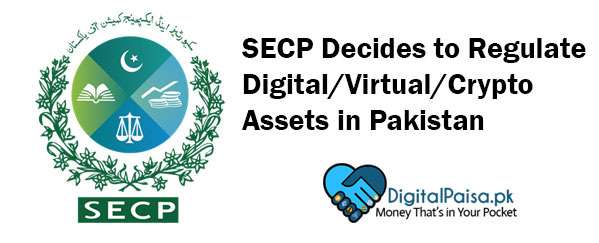The economy of Pakistan is growing rapidly and a large number of people are showing interest in the forex market. Keeping in view the growing interest of people in the forex market the Securities and Exchange Commission of Pakistan (SECP) has decided to regulate the digital and virtual assets in the country.
For the regularization of digital and virtual assets in Pakistan and also to avert the misuses of these digital currencies SEC has issued a proper framework.
The digital assets that have the EUR 7 billion value globally will be regulated in Pakistan for the very first time by any regulatory body.
In Pakistan, as per SECP regulation the customers can trade under Digital Asset Trading Platforms.
As per the notification issued by the SECP just the Asset-backed Security Tokens/Digital Assets will be regulated in Pakistan and it does not include the cryptocurrencies, virtual currencies, and the digital currencies of the central bank.
However, there is still no accord over the classification of Digital Assets, the mutuality between all of them is:
Digital/Cryptocurrencies; Utility Tokens, Digital tokens/assets
Security Tokens: either reversed by real assets or cryptographic Distributed Ledger Technology.
Objective and regulatory framework of the digital and virtual assets:
By regularization of the digital and virtual assets, the main aim of SECP is to meet the standard of the innovation and advancement in technology and to support the efficient and safe financial insertion efforts by the consumers of the capital market and its institutions. SECP also aims to ensure the investor’s protection, reducing the opportunities for regulatory sale/purchase, struggle to the circumvention of trade control rules and regulations; unlawful financial surges, money laundering, and the patronage of terrorism in the country.
Regulation of digital assets and virtual assets in Pakistan:
The regularization of the digital assets and virtual assets in Pakistan is the new beginning of Digital Financing which will open the gates of the new regulatory measures and approaches to the digital markets around the world. There was a need for a new beginning in the digital market which will change the regulatory measures as they are currently acknowledged to the regulators around the world.
Digital assets have been treated in different ways by the regulators globally and this is the main reason that the Digital Assets have not been given the proper definition. Some of the regulators globally giving primary significance to the functioning viewpoint of digital assets whereas others have taken an come up to describe them to be able to build the strong regulations to lessen Anti-Money Laundering, supporting terrorism, and tax prevarication fears for their particular laws.
SECP described that the main issue is the importance of digital assets because their illegal use is still unknown while its market value is surpassing the 7billion EUR globally.
As per the SECP viewpoint, there is no requirement to build up a policy and regulatory response to Digital Assets in Pakistan, determined by the following:
• Digital assets are a type of novelty that may collide with the financial region of the country.
• Digital assets do not robust within the existing regulatory structure.
• Digital assets may generate circumstances for regulatory sale/purchase though associated with risks.
• Growing interest, investment and participation in Digital Assets.
Moreover, SECP has also shared accessible perspectives to regulate digital assets.
Available approaches for regularization:
Digital assets can be regulated and limited by the existing guideline and may in certain examples even involve out forbidding. Under this methodology, beginners are obliged to adjust to the existing regulatory guideline.
The second supposition is described by the Commodity Futures Trading Commission (CFTC) as ‘let-things-happen’ as the ‘do-not-harm’, where the financial sector is believed as active and the associated need to diversify is strongly highlighted.
The do-not-harm approach is highly appraised for not allowing overregulation smother novelty and supports finding the finest balance between innovation, the associated risks, and the wider safety of the financial system.
Moreover, SECP has also described the two types of Digital Assets i.e. Utility Token and Security Token.
Utility Token
Utility Tokens are intended to use for the specific purpose within the platform for which they are designed. Customers can make use of the utility tokens for the payments of goods within the platform.
For example, Medipedia Platform – A blockchain-based healthcare startup designed for Medical Tourists. Medipedia has designed utility tokens i.e. MEP tokens can be used for payment of healthcare services within the Medipedia platform.
Security Token
Security tokens on the other hand are designed for the investment purpose through a primary security offering is classified.
Such tokens have a resemblance to the financial instruments than to cash. Security tokens should be considered as such assets granting rights such as ownership, right to share in future profits or cash flows, or payment of a precise sum of money (e.g., dividends).
The asset tokenization of actual assets on dispersed ledgers or the issuance of traditional asset classes in the tokenized variety with the application of smart contracts has the perspective to offer a bunch of benefits over the traditional system.
These comprise precision i.e. close to unfeasible duplication/cheating avenues inbuilt in the system; Enhanced liquidity potential i.e. permitting tradability of illiquid assets; competence achieved due to disintermediation and mechanization; relatively competent clearing and agreement mechanisms.
In addition to the above-mentioned benefits, a rather ground-breaking impact of security tokens lies in its inbuilt potential to democratize the financial systems i.e. by permitting partial possession of assets which will further grounds lowering of barriers to investment and comprehensive access to sell investors to formerly unaffordable or inadequately divisive asset classes.
Primary Market of Security Tokens:
However, registering the Initial Exchange operators (IEO’s), who shall perform the payable diligence to permit public offering through the capital market by mode of issuing security tokens. The most plausible procedure can be an issuer to submit its application including a white paper to an IEO operator for consent.
The IEO operator will then assess the issuer and white paper and, if accepted, facilitate the offering of the tokens to shareholders.
The SECP will be working with the IEO operator in assessing the IEO issuer. Once accepted, the public may then invest in the issuer’s tokens from the IEO gateway. This would demand the scheming policy to register Initial exchange operators (IEO’s) as well as recommend a standard to operate as such by the Commission. As a result, the IEO’s can only be offered by listed operators meeting the appropriate criteria.
Secondary Digital Assets Trading:
An option would be to permit IEO’s for secondary trading as Decentralized Exchange Platforms (i.e. performing the services of trading; arrangement and custodian). The second option could be to independently register Digital Assets Trading (DAT) operators, DAT operator shall be providing the services of trading arrangement and custodian services. The third option could be permitting secondary trading through Pakistan Stock Exchange, and the traditional mechanism of settlement and custody be followed.
Conclusion:
So as to assess the above, SECP has shown the optimistic responses for the regularization of the digital and virtual assets in Pakistan and consulted the various approaches and arguments.
SECP has considered the two approaches either to completely ban all virtual assets and then go forward slowly for the regularization. Secondly, is pondering over the approach of ‘Let the things happen’ gradually and also appraised the ‘do-not-harm approach’ which will comprise the innovation, concerned threats and the security of the financial structure.
SECP is planning to study and assess the possessions of the distributed ledger, digital assets and other pioneering technologies and pushing market contributors to get engaged with the regulator.
SECP also intends to hold numerous debate sessions and welcomes any input/comments.

